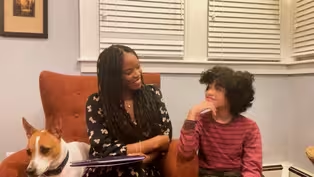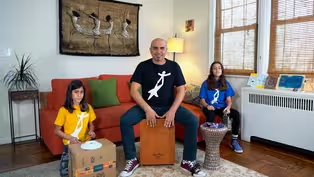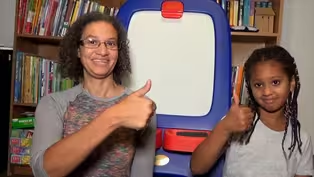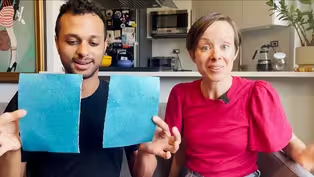
Objects and Money from Long Ago
Clip: 4/3/2023 | 9m 43sVideo has Audio Description, Closed Captions
Cheyney McKnight from New-York Historical Society shows objects and money from long ago.
Join Cheyney McKnight from the New-York Historical Society as she shows objects and money used long ago. Learn how she-merchants sold goods in exchange for money made of silver and gold. Compare buying and selling goods in the past to practices today.
See all videos with Audio DescriptionADProblems playing video? | Closed Captioning Feedback
Problems playing video? | Closed Captioning Feedback
Let's Learn is a local public television program presented by THIRTEEN PBS

Objects and Money from Long Ago
Clip: 4/3/2023 | 9m 43sVideo has Audio Description, Closed Captions
Join Cheyney McKnight from the New-York Historical Society as she shows objects and money used long ago. Learn how she-merchants sold goods in exchange for money made of silver and gold. Compare buying and selling goods in the past to practices today.
See all videos with Audio DescriptionADProblems playing video? | Closed Captioning Feedback
How to Watch Let's Learn
Let's Learn is available to stream on pbs.org and the free PBS App, available on iPhone, Apple TV, Android TV, Android smartphones, Amazon Fire TV, Amazon Fire Tablet, Roku, Samsung Smart TV, and Vizio.
Providing Support for PBS.org
Learn Moreabout PBS online sponsorship[bright music] - Welcome to Let's Learn Living History.
I'm Miss Cheyney from New York Historical Society.
Today, I'm wearing a very typical outfit that women in the 18th century would've been wearing.
It's called an English gown.
And you'll notice that there are no zippers on this gown.
There aren't even any snaps or buttons.
I'm just pinned in with straight pins.
Today, we're gonna learn about a very special group of women, the she-merchants.
They're from 18th century New York.
That's about 250 years ago.
Now, to get started, we need to learn some definitions.
The first one is merchant.
Now a merchant 250 years ago, imported goods, meaning bringing goods from around the world to sell here in New York, exported goods, meaning taking goods produced here in New York and selling them around the world.
They also warehoused goods, meaning storing them, usually in a large warehouse.
And they also just simply sold them, sometimes in a store.
Just a regular store in the 18th century.
Last definition we want to learn about is she-merchants.
And a she-merchant is just a female merchant.
It wasn't very creative, was it?
A famous she-merchant was Mary Alexander.
And she specialized in haberdashery.
I love that word.
Haberdashery is just anything extra you add onto your clothes to make them look pretty.
Things like ribbon or fancy buttons or lace.
It all can be added on to add a little something extra to your clothes.
Now, we actually have something in our collection here at New York Historical Society that was from Mary Alexander and that was her sample book.
Take a look at this page from her sample book.
You'll notice that there are some beautiful colors represented here, a lot of different types of fabrics and lace.
You'll notice that there's even some silver lace.
Did you know that lace could be made from metal?
I bet someone who wore a gown that had this haberdashery would look fabulous.
Now we're gonna take a look at some of the items she-merchants were selling.
We're gonna start over here.
This is a porcelain bowl.
Can you guess where this porcelain bowl was imported from in the 18th century?
If you said China, you're correct.
Chinese porcelain was the most popular.
So much so that it was just referred to as China.
Now this is a custom made bowl.
This means that the person who had this made had to go through two different merchants, as well as an agent that went in between the two merchants to get this custom made.
Very, very expensive.
Most Chinese porcelain was expensive because it came all the way from China.
Next item, take a look.
Can you guess what this item is?
If you said sugar, you're correct.
Now this is how sugar was transported in the 18th century, in a cone shape.
This sugar was produced in the West Indies, in the Caribbean, places like Jamaica.
Now sugar was produced using slave labor.
Enslaved persons, meaning people who were owned by other people.
Now in order to get the sugar off of this cone, you have to use something called a sugar nipper.
And you just snip it off or you simply can take a knife and scrape off the sugar to make your cake.
This one I think will trip you up a little bit.
Take a look.
What do you think this item is?
No, it's not chocolate.
I got you.
This is actually a tea brick.
Now tea in the 18th century was stored in bricks like this so that they could be transported more easily.
Can you guess where this tea comes from?
If you said China, you're correct.
And again, this would be very expensive as well because it comes all the way from China.
But it was very popular here in New York.
Next item, I'm sure you know what this is.
Yes, it's a ribbon.
Another example of haberdashery, my favorite word.
Very soft.
This is a silk ribbon and this comes to us from France.
Next item.
Can you guess what this is?
Mm, it smells so good.
They're spices.
We have some cinnamon here and we have some cloves as well.
They smell so good.
In the 18th century, these came to us from what's now modern-day Indonesia and it was a colony of the Dutch during the time.
Now we're going to participate in an activity.
I'm gonna show you an item and you can decide if you would like to purchase it and I'm gonna tell you how much that item costs and you can pass me the money and I'll pass you the good.
Now we're gonna talk about coins in the 18th century because all of these items cost different amounts.
We're gonna first start with the coin that is worth the most.
First one is a gold shilling.
And can you believe that a gold shilling was actually made with real gold.
Then we have a silver shilling.
Do you know what a silver shilling was made of?
That's right, silver.
And then we have a haypenny.
How much do you think a haypenny was worth.
Half of one cent.
That's such a small amount.
Next, we're gonna take a look at the largest coin, the Spanish real, and it is made entirelh of silver, so it would be worth more than the silver shilling because it's a lot bigger than the silver shilling.
Is everyone ready to purchase some items that she-merchants were selling?
Well, let's begin.
First item is this beautiful, custom made porcelain bowl that comes to us all the way from China.
This was custom made for General George Washington, our first president.
Now, I think this one, a very expensive item, would've been a gold shilling.
Would you like to purchase this item?
If so, I would need one gold shilling, please.
That is a gold shilling.
Here is your item.
Next, we're selling the tea brick from China.
Beautiful Chinese tea.
Anyone ready for tea time?
One shilling.
All right.
Yes, that is a shilling.
Here is your tea.
Next, we're selling the ribbon, Mary Alexander's specialty.
Anyone wanna add a bit of haberdashery to their lives?
Now this is going to be a haypenny.
Remember, half of one cent.
Any takers?
A haypenny.
Yes, this is a haypenny.
Here is your ribbon.
Next, we're selling the spices.
We have some cinnamon and we have some cloves from modern-day Indonesia.
Any takers?
This one will be a Spanish real, very expensive.
Yes, this is a Spanish real.
Here are your spices.
Lastly, we have this cone of sugar.
Even though people in the 18th century used a lot of sugar, we're going to choose not to sell this item in our store today because it was produced with enslaved labor in the 18th century.
There are other options though to sweeten up your tea, like maple sugar or honey.
Mm, delicious.
Look at that, all cleaned out.
Thank you for joining us for Let's Learn Living History.
Thank you for joining us for Let's Learn Living History.
Video has Audio Description, Closed Captions
Clip: 4/3/2023 | 8m 5s | Travis Cherry shows how the animals at the Memphis Zoo are similar to humans. (8m 5s)
Video has Audio Description, Closed Captions
Clip: 4/3/2023 | 7m 38s | Maria Begg-Roberson reads Brave Miss Muffet by Dori Graham and illustrator Kyle Beckett. (7m 38s)
Create Beats with Percussion Instruments
Video has Audio Description, Closed Captions
Clip: 4/3/2023 | 10m 51s | Yakir Ben-Hur, National Dance Institute, creates beats with a variety of instruments. (10m 51s)
Video has Audio Description, Closed Captions
Clip: 4/3/2023 | 9m 56s | Anna Scretching-Cole helps children learn about the short a vowel sound. (9m 56s)
Video has Audio Description, Closed Captions
Clip: 4/3/2023 | 48s | Tomio shows children soccer moves. (48s)
Video has Audio Description, Closed Captions
Clip: 4/3/2023 | 7m 42s | Omar Etman and Lily Fincher play math games and show children the importance of fair play. (7m 42s)
Providing Support for PBS.org
Learn Moreabout PBS online sponsorshipSupport for PBS provided by:
Let's Learn is a local public television program presented by THIRTEEN PBS





















